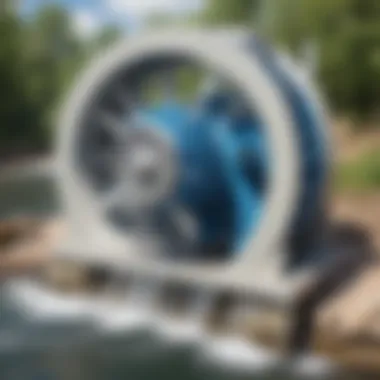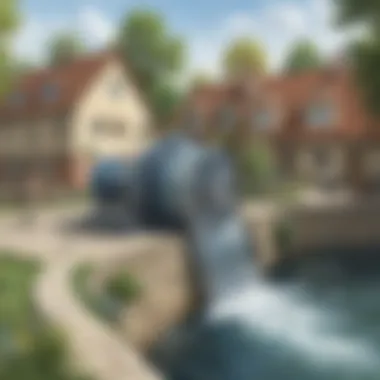Exploring Small Water Turbine Electric Generators


Intro
Small water turbine electric generators represent a fascinating intersection of engineering and renewable energy. They harness the potential energy of flowing water to produce electricity, functioning similarly to larger turbines but in a compact form suitable for various settings. For young science enthusiasts, understanding how these devices operate can open new avenues for exploring sustainability and innovation.
These generators can be used in numerous applications, from powering remote homes to supporting aquatic research stations. They offer a tangible example of how nature can meet technological needs while continuing to highlight the significance of environmental stewardship. In this article, we will dig into the mechanics of small water turbine electric generators, their design, advantages, and the broader implications of their use in renewable energy systems.
Science Fun Facts
Learning about small water turbine electric generators can be quite intriguing. Here are some interesting facts that might surprise you:
- The concept of using water to produce energy dates back to ancient civilizations, which used simple water wheels.
- A modern small water turbine can be as efficient as 90% in converting flow energy to electricity, significantly more efficient than other renewable energy sources.
- Some countries have successfully implemented small, modular turbines that can be easily transported and installed in rivers with minimal disruption to the ecosystem.
"Small hydropower systems can provide reliable electricity to remote locations, helping communities thrive without depending on fossil fuels."
Discover the Wonders of Science
Understanding how these small water turbines work requires a closer look at the science of fluid mechanics and energy conversion. Here are some concepts worth exploring:
Exploring Various Scientific Concepts
- Kinetic Energy: Water flowing in a river possesses kinetic energy, which can be transformed into electricity via turbines.
- Mechanical Advantage: The design of turbines allows for maximizing energy extraction from the water flow.
- Energy Conversion: This involves changing kinetic energy from moving water into electrical energy that can be used in homes or industries.
Real-Life Applications of Science
- Small turbines can be used in irrigation systems, providing power for pumps and enhancing efficiency.
- They aid in reducing carbon footprints in communities by offering clean and sustainable electricity.
Science Quiz Time
To make learning engaging, here are a few simple questions:
- What type of energy do small water turbines convert?
- Are small water turbine systems likely to disrupt local ecosystems?
- A. Solar Energy
- B. Thermal Energy
- C. Kinetic Energy
- A. Yes
- B. No
Answers:
- C
- B
Science Experiment Showcase
If you're interested in practical applications, conducting a small experiment can be enlightening:
Fun and Engaging Experiments
- Materials List:
- A small water wheel (can be crafted or purchased)
- A multimeter (to measure electricity)
- A water source (like a garden hose or stream)
Step-by-Step Instructions
- Position the water wheel at an angle, allowing water to flow onto it.
- Connect the multimeter to the water wheel to measure the generated electrical energy.
- Observe how changing the amount of water flow affects the output.
Safety Tips and Precautions
- Ensure all electrical connections are secure and insulated to prevent short circuits.
- Be cautious around water to avoid slips or falls.


Engaging with these aspects of small water turbines not only enriches knowledge but also showcases the significance of renewable energy solutions. Let your curiosity lead the way as you explore the mechanics, science, and applications of these important devices.
Intro to Small Water Turbines
Small water turbines are an important piece of technology in the realm of renewable energy. Understanding them provides significant insights into how we can harness natural water flow for electricity. These devices convert the energy from moving water into electric power, offering a clean and sustainable source of energy.
The relevance of small water turbines is growing as society seeks low-impact, renewable energy solutions. They can be used in various settings, from large-scale hydroelectric plants to small, individual home systems. This versatility allows communities to tap into local water sources for power, reducing dependence on fossil fuels and contributing to environmental sustainability.
Additionally, small water turbines are beneficial in both urban and rural settings. They can power remote locations where traditional power lines may not reach. The setup of these turbines often requires less infrastructure than other renewable sources, making them a practical choice for local energy needs.
The focus on small turbines also ties into broader discussions about energy efficiency and sustainability. As technology advances, these systems are becoming more efficient and easier to install. Understanding these advancements is crucial for anyone interested in the future of energy production.
In this article, we will dive deeper into the components, mechanics, and applications of small water turbines. This exploration is aimed at enlightening young science enthusiasts and their families, providing knowledge to encourage further inquiry into renewable energy technologies.
"Harnessing the power of water is not just a scientific endeavor; it's a pathway to a sustainable future."
With proper knowledge about how these turbines work and their benefits, a new generation can become empowered to pursue ingenious solutions to energy challenges.
Principles of Electricity Generation
The topic of electricity generation is fundamental to understanding how small water turbine electric generators function. It is imperative to grasp how energy is produced and how it can be harnessed through water systems. The principles that govern this process include not only the mechanical aspects of conversion but also the broader scientific principles underlying hydroelectricity.
Understanding Hydroelectricity
Hydroelectricity encompasses the conversion of kinetic energy from flowing or falling water into electrical energy. This process typically occurs in large dams, but small water turbines achieve similar outcomes on a smaller scale. For a comprehensive understanding, it is key to consider three main components:
- Potential Energy: Water stored at height, like in a reservoir, has gravitational potential energy.
- Kinetic Energy: As water flows down, gravitational force transforms potential energy into kinetic energy, generating movement.
- Conversion: This movement can be captured by turbines, which then convert kinetic energy into mechanical energy. Finally, it is transformed into electrical energy through generators.
The principle of hydropower is efficient and sustainable; it provides a continuous energy source while reducing greenhouse gas emissions. Water is a renewable resource, making it crucial in discussions about sustainable energy options for the future.
Mechanics of Small Water Turbines
Small water turbines operate on basic mechanical principles. When water moves through a turbine, it causes blades to rotate. This rotational movement is harnessed to drive a generator, thus producing electricity. The design of small turbines can vary, but several key mechanics are common across most systems:
- Turbine Design: Turbines are designed specifically for the type of water flow they will encounter. Factors include speed and volume of the flow. Impulse and reaction turbines are common designs, each functioning differently based on water's approach.
- Generator Mechanism: The generator converts the mechanical energy from turbine rotation into electrical energy using electromagnetic induction. This process involves magnets and coils of wire.
- Efficiency: The efficiency of a turbine generator hinges on several factors like turbine design, water flow rate, and maintenance. Regular checks ensure optimal performance.
- Impulse turbines capture energy from water jets and require high flow velocity.
- Reaction turbines work by allowing water to react with blades while moving through the turbine.
Understanding the mechanics behind small water turbines is essential for recognizing their role in renewable energy production. As the demand for clean energy increases, exploring these principles illustrates how small-scale solutions can contribute significantly.
Components of Small Water Turbine Generators
Understanding the components of small water turbine generators is crucial for grasping how these systems work efficiently. These devices convert kinetic energy from flowing water into electrical energy. The key components play distinct roles in the overall functionality and effectiveness of the generator. A comprehensive understanding of these elements can clarify their benefits and considerations in various applications.
Turbine Types
Impulse Turbines
Impulse turbines are designed to harness the energy in water through a very specific mechanism. They utilize high-velocity jets of water directed against the turbine blades to produce motion. This setup allows them to work effectively even with lower water flow rates, which is essential in many environments where small turbines are placed.
A key characteristic of impulse turbines is their design, which can be simpler and more robust compared to other types. This simplicity makes them a popular choice for smaller hydro systems. The unique feature of impulse turbines lies in their ability to operate efficiently without the need for high water pressure. While they are advantageous in terms of ease of maintenance, they may not be suitable for sites with very low flow conditions.
Reaction Turbines
Reaction turbines, in contrast, generate power through the interaction between water flow and pressure across the entire turbine. They are submerged in the water flow, using both the kinetic and potential energy of the water. This design allows them to be effective under various conditions, especially where water levels fluctuate.
The key characteristic of reaction turbines is their efficiency in maximizing energy extraction from water. As they capture energy from both the flow and pressure changes, they can produce more electricity compared to impulse turbines under similar conditions. A unique feature of reaction turbines is their ability to operate well in diverse environments. However, they can be more complex to maintain than impulse turbines due to the need for regular inspection and care to ensure peak performance.


Generator Mechanisms
The generator mechanisms are the heart of the small water turbine systems. They convert mechanical energy from the turbine into electrical energy. Generally, these mechanisms rely on electromagnetic induction, where a magnetic field interacts with a conductor to produce electric current. The efficiency of this conversion process is critical to the effectiveness of the turbine system as it directly impacts energy output.
Control Systems
Control systems contribute significantly to the operation of small water turbine generators. They manage the flow of water into the turbines and oversee the functioning of the generator. By monitoring water levels and turbine performance, control systems ensure that the generator operates within safe and efficient parameters. Proper management of these systems can lead to enhanced performance and prolonged lifespan of the overall setup.
Investing in robust control mechanisms can mitigate risks associated with fluctuations in water flow and turbine efficiency.
In summary, the components of small water turbine generators, including turbine types, generator mechanisms, and control systems, all play essential roles. Their effective design and operation lead to the success of renewable energy projects. Understanding these elements is a step towards appreciating the potential of small water turbine systems for sustainable energy production.
Advantages of Small Water Turbines
Understanding the advantages of small water turbines is crucial for recognizing their potential impact in the field of renewable energy. These systems harness the power of flowing water to generate electricity, promoting a sustainable approach to energy consumption. Small water turbines are especially relevant in today's context of environmental concerns and the need for sustainable solutions. This section will explore their environmental impact as well as their cost-effectiveness and overall sustainability.
Environmental Benefits
Small water turbines offer significant environmental benefits. First, they produce clean energy without the emissions typically associated with fossil fuels. This means that, when installed correctly, they can help reduce greenhouse gas emissions, contributing to a decrease in climate change impacts. The water that drives these turbines remains available for aquatic ecosystems, and the mechanisms are usually designed to minimize disruptions to local wildlife.
In many cases, the installation of small water turbines can coexist with natural habitats. Unlike large hydroelectric projects, small turbines tend to have a lower footprint, preserving the natural landscape. With minimal impact on natural water flow, the ecological balance can remain intact, supporting local flora and fauna.
"Small water turbines exemplify how technology can align with environmental goals, harnessing energy while preserving ecosystems."
Moreover, they can be installed in remote areas where traditional power supply systems are either unavailable or too expensive to implement. This leads to a potential reduction in reliance on diesel generators, which often cause fuel pollution. By utilizing a renewable resource, communities can benefit from a more stable and clean source of electricity.
Cost-Effectiveness and Sustainability
The cost-effectiveness of small water turbines is another important factor. Although the initial investment can be significant, the long-term savings on energy costs often justify the expenses. Once installed, these systems typically require minimal maintenance, leading to lower operational costs over time. This makes them an attractive option for both private households and businesses.
Sustainability is at the core of small water turbine technology. They allow for the continuous generation of power, as long as water flow is available. This ensures a more stable energy source compared to other renewable solutions, such as solar panels, which have energy production limitations due to weather conditions. As a result, small water turbines contribute to a more reliable local energy grid.
Additionally, government grants and incentives aimed at renewable energy projects often support the installation of these turbines, making them financially viable for many users. The combination of clean energy production and reduced operational costs ultimately enhances their overall sustainability in the long run.
Applications of Small Water Turbine Generators
Understanding the practical applications of small water turbine electric generators is crucial for realizing their potential in renewable energy. These generators serve various purposes and can significantly contribute to energy needs in different environments. This section elaborates on how small water turbines can be integrated into daily life and the essential considerations involved.
Home Energy Solutions
One of the most compelling uses of small water turbine generators is in home energy production. Households near water sources such as rivers or streams can harness the kinetic energy of flowing water to generate electricity. This setup not only reduces the dependence on traditional energy sources but can also lower energy bills over time.
The components of a small water turbine system for homes typically include a water intake structure, the turbine itself, a generator, a control unit, and storage batteries. Each part plays a critical role:
- Water Intake: Diverts water from the source without disturbing the aquatic ecosystem.
- Turbine: Converts the flow of water into mechanical energy.
- Generator: Transforms mechanical energy into electrical energy.
- Control Unit: Manages output and ensures stable energy production.
- Storage Batteries: Provide a backup that stores excess energy for later use.
The environmental benefits from these installations should not be overlooked. Small turbines contribute to a green energy ecosystem. However, to be effective, homeowners must consider the water flow rate at their site and local regulations concerning water diversion and energy generation.
Remote and Off-Grid Locations
In remote or off-grid locations, small water turbine generators shine as viable energy solutions. Many communities in isolated areas often struggle with reliable access to electricity. Small water turbines can help fill this gap, providing a consistent and sustainable energy source.
Benefits of deploying small turbines in remote settings include:
- Energy Independence: Reduces reliance on fuel deliveries or centralized power grids.
- Sustainability: Utilizes a renewable resource that is often abundantly available in hilly or mountainous areas.
- Low Maintenance: Once established, these systems have relatively low operational costs compared to fossil fuel generators.
Challenges to consider in these applications include the initial setup costs and the need for site assessment to ensure enough water flow for efficiency. Access to spare parts and system repair options can also be limited in these locations.


As communities and technologies evolve, integrating small water turbine generators into everyday life is not just beneficial but necessary. The potential extends beyond mere energy production; it encompasses encouraging self-sufficiency, contributing to environmental health, and fostering local economies.
The deployment of small water turbine generators not only enhances energy access but also promotes sustainability in various environments.
In summary, small water turbine electric generators have vital applications. They cater to both residential needs and the energy demands of remote locations. Understanding these applications helps to leverage their benefits effectively.
Challenges and Considerations
When discussing small water turbine electric generators, it is crucial to address the challenges and considerations involved in their implementation. Understanding these factors can lead to better planning and enhance the efficiency of energy generation. There are various elements to take into account, from site assessment to maintenance. Each factor influences not only the effectiveness of the turbines but also their longevity and environmental impact.
Site Assessment and Planning
Site assessment is a fundamental step in the process of installing a small water turbine generator. This involves evaluating the location where the turbine will be placed. Key elements include:
- Water flow rate: Assessing the average flow of the water source helps in calculating how much energy can be generated. A higher flow rate typically leads to more electricity being produced.
- Head measurement: This is the vertical drop of water. More head means more potential energy, as the water descends from a higher elevation.
- Environmental impact analysis: Before installation, an understanding of the local ecosystem is necessary. It is essential to consider how a turbine might affect fish populations and other wildlife.
- Accessibility: The selected site must allow for easy access for both installation and ongoing maintenance.
Conducting a thorough site assessment can prevent many issues. For instance, if a location is too remote or the flow is inconsistent, the investment might not yield the desired returns.
Maintenance Requirements
Maintaining small water turbine generators is vital for ensuring their efficiency and lifespan. Regular maintenance reduces the likelihood of major repairs and increases productivity. Key maintenance tasks include:
- Routine inspections: Regular checks help identify wear and tear early. Inspecting components like bearings, blades, and control systems is essential.
- Cleaning the turbine: Accumulated debris can decrease the efficiency of the turbine. Clear pathways and areas around the turbine must be kept clean, especially after heavy rains or floods.
- Lubrication: Proper lubrication of moving parts is necessary to minimize friction and wear. This ensures that the turbine operates smoothly.
- Electrical system checks: Monitoring the generator and control systems ensures everything operates efficiently. Electrical components should be inspected regularly to avoid failures.
In summary, addressing the challenges and considerations surrounding small water turbine generators requires thorough site assessments and diligent maintenance practices. Careful planning and execution can greatly enhance the performance and sustainability of these renewable energy solutions.
The Future of Small Water Turbine Technology
The advancement of small water turbine technology plays a crucial role in the evolution of renewable energy solutions. As the world seeks sustainable ways to produce electricity, small water turbines are becoming more relevant. They offer not only efficient energy generation but also a low environmental footprint. The future of these technologies is characterized by innovations in design and integration with other renewable energy sources.
Innovations in Design
Current trends in design focus on enhancing efficiency and performance. Manufacturers are looking to create turbines that can operate effectively in varying water conditions. Innovations such as variable pitch blades allow turbines to adapt to different flow rates without losing efficiency. This adaptability is critical, especially in environments where water flow can change due to seasonal variations.
Moreover, the integration of smart technology is shaping the future. Sensors and monitoring systems can provide real-time data on performance and maintenance needs. This innovation ensures turbines run efficiently, reducing downtime. Incorporating advanced materials that are lightweight yet durable also helps in improving the design of small water turbines. These materials increase resilience and lifespan, ultimately leading to better return on investment for users.
Integrating with Other Renewable Sources
The future of small water turbines also involves collaboration with other renewable energy sources. By combining water turbines with solar panels or wind turbines, a more consistent energy supply can be achieved. For instance, in locations where sunlight is limited, coupling solar energy with water turbines can provide a stable energy system. This synergy can ensure energy availability throughout the year.
Additionally, microgrid systems can benefit significantly from the integration of diverse renewable sources. Such systems can store energy from different sources and distribute it according to demand. This approach enhances energy resilience in communities that rely on intermittent power sources.
In summary, the future of small water turbines is bright. Innovations in design and integration with other renewable sources enhance their potential. As technology progresses, small water turbines will likely play a more substantial role in achieving sustainability goals globally.
Closure
In this section, we will outline the key significance of small water turbine electric generators. The broader context of renewable energy makes understanding these generators especially relevant today. These systems not only provide sustainable electricity but also contribute to ongoing efforts to combat climate change.
Summary of Insights
Small water turbine electric generators serve as a viable energy source that leverages the natural flow of water. Their design considers both efficiency and environmental impact. Key insights include:
- Sustainability: Utilizing water flow reduces reliance on fossil fuels.
- Cost Efficiency: Lower operational costs make them attractive for residential and remote applications.
- Technological Innovation: Continuous advancements enhance performance and integration capabilities.
These elements showcase how small water turbines can fit into a sustainable energy landscape, promoting energy independence and reducing carbon footprints.
Encouragement for Exploration
As we conclude, it’s important to encourage curiosity and exploration in the field of renewable energy. Understanding small water turbines opens doors for young minds. They can learn about electricity generation, environmental care, and innovative technologies. Whether through hands-on projects or further reading, engaging with these concepts is vital. Exploring resources like en.wikipedia.org, britannica.com, or related discussions on reddit.com can deepen understanding.
"The future of energy lies in the hands of the curious. Learning about generators today can spark innovation tomorrow."
Whether through school projects or discussions with family, every step taken in understanding small water turbine generators is a step toward a greener future. Encouragement to explore this field can inspire future engineers, scientists, and environmentalists.







